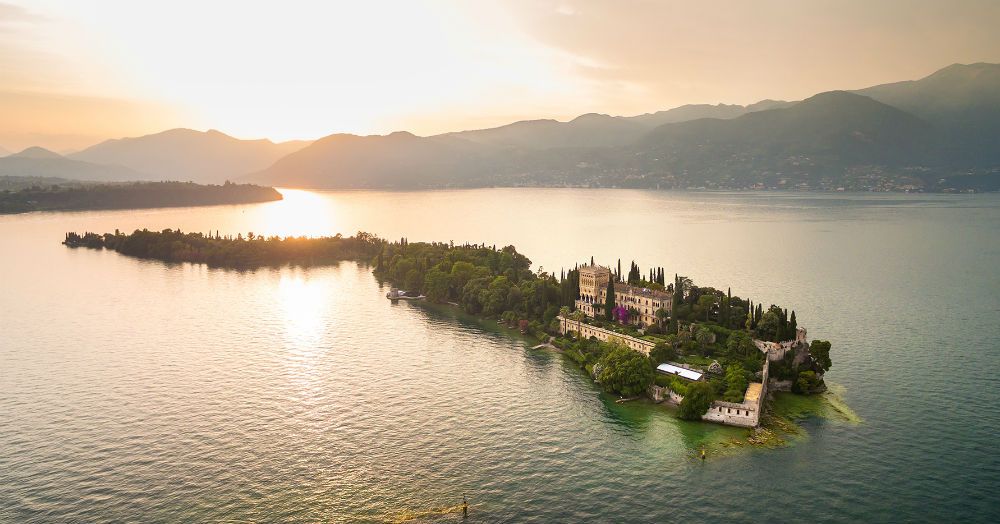
Isola del Garda – hidden beauty in your golf holiday in Italy
Isola del Garda (Island of Garda) is certainly one of the most fascinating premium activities among the many proposals in the Italy4golf Experiences dedicated to Northern Italy.
The day reserved for this activity within the Italy4golf exclusive golf tourism is peculiar because it offers a series of unique experiences, from access to the island by private boat up to the possibility of enjoying a bath, also private, in the crystal clear waters of the cove behind the island.
But the Isola del Garda is also a concentrate of history, art, architecture, botany (also exotic), and of great beauty that originates from the continuous improvement and enrichment carried out by each of its owners over the centuries.




The villa
The charm of the Isola del Garda comes from the extraordinary Venetian neo-Gothic style villa, designed by the architect Luigi Rovelli in the early 1900s; an imposing harmonic construction, full of surprising architectural details. At its feet, Italian terraces and gardens slope down to the Lake. All around the vegetation is luxuriant and intact, rich in local but also exotic plants, rare essences and flowers.




The gardens and the park
On the central terrace in front of the villa, the garden is in classic Italian style with expertly modelled hedges representing various figures, including the emblem of De Ferrari, the family that gave the impetus to the creation of this garden.
Next to the villa, palm trees from the Canaries grow. On the lower terrace, by the Lake, there are fruit tree such as khaki, lemons, pears, pomegranates, olive trees, oranges, grapefruits, prickly pears, jujubes and capers. There are also rosy China roses, Lady Hillingdon roses, yellow Banksia roses, valerian, bougainvillaea and many other plants and flowers of rare beauty.
The most suggestive and wild part is located in the flat area of the Island, where you can walk in the shade of evergreen cypresses, swamp cypresses, deciduous oaks, cedars, poplars, laurels, plane trees, firs and pines of various species interspersed with shrubs and more typically Mediterranean essences. This park still remains a well-kept secret, only recently opened to visitors’ sensitivity.








Historical background of the Isola del Garda
The Isola del Garda has been known for centuries with different names, almost always linked to the different owners. To demonstrate that the Island was already inhabited in Roman times there are the 130 Gallic-Roman tombstones found here and then donated to the Roman museum in Brescia by Count Luigi Lechi.
Abandoned to itself in the centuries of the decline of the Roman Empire, it was used as a hunting reserve. Later, part of it was donated to Francesco d’Assisi who visited it in 1220, considering it the ideal place for his friars. The Saint established a simple hermitage and the Franciscan friars never abandoned this solitary place despite the constant incursions of soldiers from Brescia, Veronese and Mantovane.
In the Renaissance period, the old monastery was renewed and enlarged and the Isola del Garda became an important ecclesiastical meditation centre which hosted illustrious religious figures. With the arrival of Napoleon, the Island was annexed to the Cisalpine Republic and the old monastery was suppressed.




Later it became state property and, in the following years, it had several owners until Count Luigi Lechi of Brescia (1817) who ordered important restoration and construction works and then sold it twenty years later to his brother Teodoro, former general of Napoleon’s army who made further changes with the addition of the terraces in front of the villa.
Expropriated by the state and assigned to the army in 1860 (close to the unification of Italy), the idea of building a fortress was however abandoned and it was decided to be sold at auction. The property was awarded to Baron Scotti who sold it to the Duke Gaetano de Ferrari of Genoa and his wife, the Russian Archduchess Maria Annenkoff. They dedicated themselves to the design and construction of the park.
The extremely complex building of the Villa has, in fact, its stylistic unity and a rare grandeur. The facades are decorated with pointed arched windows and in the south west corner stands a tower crowned with stone embroidery battlements with neo-Gothic floral decorations. The Island has seen no further changes of ownership, except along the same descent of the Ferraris who first linked to the Borghese of Rome and then to the Cavazza of Bologna, whose descendants continued to live, preserve and beautify the Isola del Garda up to the present day.
More info at www.isoladelgarda.com
See Italy4golf Experiences
Cristina De Rossi
Italy4golf Italian Ambassador
Images courtesy of www.isoladelgarda.com
Archduchess Maria Annenkoff, architect Luigi Rovelli, Baron Scotti, Borghese family, Cavazza family, count Luigi Lechi, De Ferrari family, Duke Gaetano de Ferrari, Isola del Garda, Italian gardens, Italy4golf Experiences, Lake Garda, Napoleon, Venetian neo-Gothic style




